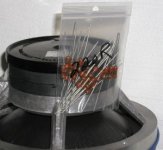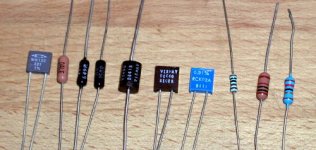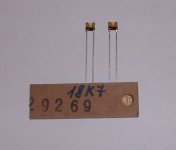So get some iron core chokes and the Russian surplus caps, and you could do your entire crossover without even needing a board to attach it to. Stick the parts to the magnet and solder away.Peter Daniel said:Got some tantalum resistors from Partsconnexion. They are magnetic. Didn't dheck them for sound yet.
I'd be interested in what you think of the Tants. I've used Kiwames and Beyschlags with steel endcaps and find them very nice for the money.
Cheers
Peter Daniel said:I can't wait for Dorkus anymore.
sorry, i am slow. that whole girlfriend thing.
Newbie question.
If I may ask, how do 1 recognise the differant resistor brands. Are there certain markings, colors or other way to tell them apart?
Where I buy my components, the sales people just say they order the parts from a supplier overseas and they do not know which brand it is.
If I may ask, how do 1 recognise the differant resistor brands. Are there certain markings, colors or other way to tell them apart?
Where I buy my components, the sales people just say they order the parts from a supplier overseas and they do not know which brand it is.
The usual suspects
Different brands have different sizes, shapes and colors. The better ones sometimes don't have color coding but the value and tolerance written on them.
Just what I have on hand right now.
From left: Caddock MK132, Dale, old Holco, new Holco, Vishay, Vishay S102, Vishay Sfernice, BC, Dale (used by ML and Krell) and your generic metal film.
Different brands have different sizes, shapes and colors. The better ones sometimes don't have color coding but the value and tolerance written on them.
Just what I have on hand right now.
From left: Caddock MK132, Dale, old Holco, new Holco, Vishay, Vishay S102, Vishay Sfernice, BC, Dale (used by ML and Krell) and your generic metal film.
Attachments
More usefull info
Thanx Peter for that quick pic.
Here is a thread I picked up re: the same subject with some more usefull thoughts.
http://diyaudio.com/forums/showthread.php?s=&threadid=366
Thanx Peter for that quick pic.
Here is a thread I picked up re: the same subject with some more usefull thoughts.
http://diyaudio.com/forums/showthread.php?s=&threadid=366
I did some comparison today, between two resistors directly in a signal path (20K value):
Vishay VTA55: sounded laid back, sort of mellow, darker in character, tubelike with midrange in the first plan
Rikken: more open than Vishay, with kinda etched highs and more detail there, bass also better defined and overall more SS sound.
My choice would go to Rikkens.
Vishay VTA55: sounded laid back, sort of mellow, darker in character, tubelike with midrange in the first plan
Rikken: more open than Vishay, with kinda etched highs and more detail there, bass also better defined and overall more SS sound.
My choice would go to Rikkens.
Nude Vishays
Just got a pair of custom manufactured 270 ohm +/-0.05% tolerance naked Vishay S102C resistors from Texas Components (for a passive DAC I/V).
Haven't tried them in circuit yet, so I cannot comment on thier sonics. But, Arbie at Texas Components was **very** helpful, and they seem to not have a problem with small orders to DIY audio folk. The resistors were $6.10 each (generally the higher the resistance the higher the cost), no minimum, and shipped for 60 cents in a regular envelope.
Give them a try at: http://www.texascomponents.com. Their part numbers for the naked S102C series is TX2352.
Just got a pair of custom manufactured 270 ohm +/-0.05% tolerance naked Vishay S102C resistors from Texas Components (for a passive DAC I/V).
Haven't tried them in circuit yet, so I cannot comment on thier sonics. But, Arbie at Texas Components was **very** helpful, and they seem to not have a problem with small orders to DIY audio folk. The resistors were $6.10 each (generally the higher the resistance the higher the cost), no minimum, and shipped for 60 cents in a regular envelope.
Give them a try at: http://www.texascomponents.com. Their part numbers for the naked S102C series is TX2352.
Attachments
Texas Component's TX2352 sounds very good indeed. The perceived tonal balance is quite flat, and compared to an S102K, it is less electronic-sounding overall (from soft to loud, and from bottom to top), with better low-level resolution and dynamic linearity. Imaging is more rounded and less stark. The overall perception is of a resistor that doesn't have any significant quirks and doesn't accentuate any specific aspect of the sound.
Also, the TX2352 sounds good immediately upon power-up, while the S102K needs more aging time to come on song. Even then, it never quite manages to reach the TX2352.
Physically, the TX2353 is less rugged than the S102K, but isn't fragile per se. Handle it with reasonable care, and you should have no problems. The resistive wafer may appear "nude", but it is coated with a transparent and fairly strong insulative coating, so you don't need to worry about inadverdent short-circuits. Lead pitch is the same as the S102K (3.81mm, I believe), so a TX2352 can replace an S102K with no layout changes.
Unless I need a resistor with very specific properties, the TX2352 would certainly be at or near the top of my list.
Besides, the folks at Texas Components are nice people, so do feel free to order from them!
hth, jonathan carr
Also, the TX2352 sounds good immediately upon power-up, while the S102K needs more aging time to come on song. Even then, it never quite manages to reach the TX2352.
Physically, the TX2353 is less rugged than the S102K, but isn't fragile per se. Handle it with reasonable care, and you should have no problems. The resistive wafer may appear "nude", but it is coated with a transparent and fairly strong insulative coating, so you don't need to worry about inadverdent short-circuits. Lead pitch is the same as the S102K (3.81mm, I believe), so a TX2352 can replace an S102K with no layout changes.
Unless I need a resistor with very specific properties, the TX2352 would certainly be at or near the top of my list.
Besides, the folks at Texas Components are nice people, so do feel free to order from them!
hth, jonathan carr
Sound of Resistors
I am a bit confused by your post as the TX2352 is actually a "processed" Vishay S102.
I find it hard to believe that the processing makes a that large difference.
But I also did not hear any difference between a regular metalfilm resistor and a Vishay VSH.

Hi Jonathan,jcarr said:Texas Component's TX2352 sounds very good indeed. The perceived tonal balance is quite flat, and compared to an S102K, it is less electronic-sounding overall (from soft to loud, and from bottom to top), with better low-level resolution and dynamic linearity. Imaging is more rounded and less stark. The overall perception is of a resistor that doesn't have any significant quirks and doesn't accentuate any specific aspect of the sound.
Also, the TX2352 sounds good immediately upon power-up, while the S102K needs more aging time to come on song. Even then, it never quite manages to reach the TX2352.
Physically, the TX2353 is less rugged than the S102K, but isn't fragile per se. Handle it with reasonable care, and you should have no problems. The resistive wafer may appear "nude", but it is coated with a transparent and fairly strong insulative coating, so you don't need to worry about inadverdent short-circuits. Lead pitch is the same as the S102K (3.81mm, I believe), so a TX2352 can replace an S102K with no layout changes.
Unless I need a resistor with very specific properties, the TX2352 would certainly be at or near the top of my list.
Besides, the folks at Texas Components are nice people, so do feel free to order from them!
hth, jonathan carr
I am a bit confused by your post as the TX2352 is actually a "processed" Vishay S102.
I find it hard to believe that the processing makes a that large difference.
But I also did not hear any difference between a regular metalfilm resistor and a Vishay VSH.

THE SOUND OF IT.
Hi Elso,
The Vishay S102 bulkfoils have a rep for sounding as close to no resistor at all.
I can only confirm that from my own experiences.
The nude ones build on that quality and take it a step further even when their not really unprotected as their name suggest.
I would heartily recommend them as series Rs in sa stepped attenuator at the most used positions (to keep the price down) and have a listen for yourself.
Cheers,
Hi Elso,
The Vishay S102 bulkfoils have a rep for sounding as close to no resistor at all.
I can only confirm that from my own experiences.
The nude ones build on that quality and take it a step further even when their not really unprotected as their name suggest.
I would heartily recommend them as series Rs in sa stepped attenuator at the most used positions (to keep the price down) and have a listen for yourself.
Cheers,
Vishay VTA55: sounded laid back, sort of mellow, darker in character, tubelike with midrange in the first plan
Rikken: more open than Vishay, with kinda etched highs and more detail there, bass also better defined and overall more SS sound.
My choice would go to Rikkens. [/B][/QUOTE]
--------------------------------------------------------------
You need to repeat with resistors in both directions. Can make a big difference. I tried Vishay and Rikken in passive preamp mounted in opposite directions. I prefer the Vishay . Direction makes the difference in terms of sonic balance.
Rikken: more open than Vishay, with kinda etched highs and more detail there, bass also better defined and overall more SS sound.
My choice would go to Rikkens. [/B][/QUOTE]
--------------------------------------------------------------
You need to repeat with resistors in both directions. Can make a big difference. I tried Vishay and Rikken in passive preamp mounted in opposite directions. I prefer the Vishay . Direction makes the difference in terms of sonic balance.
- Status
- This old topic is closed. If you want to reopen this topic, contact a moderator using the "Report Post" button.
- Home
- Design & Build
- Parts
- resistor comparison test - tantalum?



